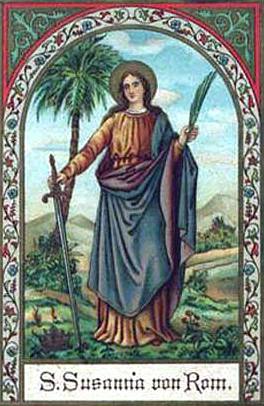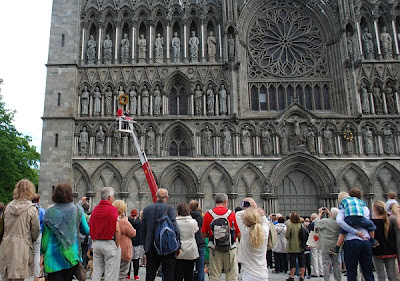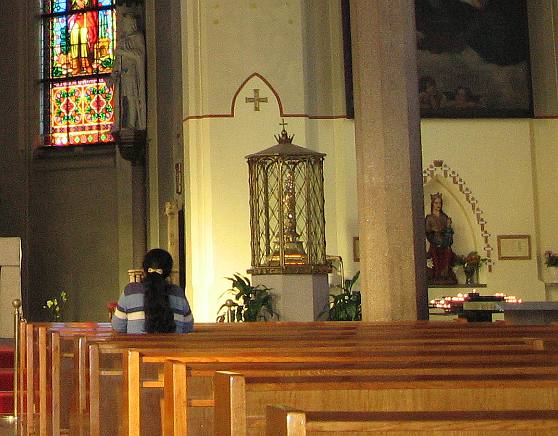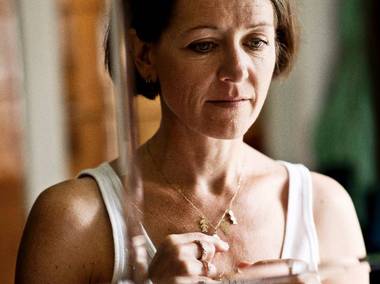Jeg – som leser de tradisjonelle tidebønnene, men oftest feirer messer etter den nye kalenderen – har i dag markert to helgener; den hellige Teresa Benedikta av korset, som også er en av vernehelgenene for Europa, og forberedt meg denne vigiliedagen til å feire den hellige Laurentius i morgen. De er begge viktige martyrer, men dette er også eksempler på at det bør bli en justering av de to kalenderne.
Dagens messe for den hellige Teresa Benedikta inneholdt bl.a. følgende:
Kollektbønn:
Herre, våre fedres Gud, da den salige Teresa Benedikta møtte sitt martyrium, førte du henne inn i fylden av kunnskapen om korset. Fyll oss med den samme kunnskap, og la oss på hennes forbønn alltid søke deg, den Høyeste Sannhet. Gi oss å forbli trofaste inntil døden i din kjærlighets pakt, den du tegnet med din Sønns blod til frelse for alle mennesker. Han som lever og råder …
Lesning – Hos 2, 14b.15b.19-20
Så sier Herren: Se, jeg vil lokke henne, føre henne ut i ørkenen og tale vennlig til henne. Der skal hun svare meg som i ungdommens dager, som den gang hundrog opp fra Egypt. Jeg vil trolove meg med deg for alltid. Jeg vil trolove meg med deg i rettferd og rett, i miskunn og barmhjertighet. Jeg vil trolove meg med deg i troskap, og du skal kjenne Herren.
Responsoriesalme – Sal 45, 11-17
Omkved: Hør, min datter, gi akt og bøy ditt øre.
Hør, min datter, gi akt og bøy ditt øre, glem ditt folk og dine fedres hus. Da vil kongen finne behag i din skjønnhet. Han er din Herre, fall ned for hans fot.
I all sin prakt føres kongsdatteren inn, kledd i gullvirket kledning. Hun føres frem for kongen i fargerik drakt. Hun blir fulgt av unge piker av sine venninner
Under jubel og glede ledes de inn i kongens slott. I dine fedres sted skal sønner komme. Du skal sette dem til fyrster over hele jorden.
Evangelievers: Halleluja. Kom Kristi brud, ta imot den krone som Herren har beredt deg for evigheten. Halleluja.
Evangelium – Matt 25, 1-13
På den tid fortalte Jesus denne lignelse til sine disipler: «Så kan himlenes rike lignes med ti terner, som kom for å gå brudgommen i møte; og alle hadde sine lamper med. Men fem av dem var uforstandige, og bare fem av dem var kloke. For de uforstandige tok nok lampene, men hadde ikke olje med; de forstandige derimot tok både lampene sine og kanner med olje. Men da brudgommen lot vente på seg, falt de etter hvert i søvn og sov til sist alle. Da, midt på natten, hørtes et rop: «Brudgommen kommer! Ut og gå ham i møte!» Alle ternene våknet og gjorde lampene sine i stand. Men de uforstandige måtte si til de kloke: «La oss få litt olje av dere, for lampene våre slukner.» Da svarte de som hadde vist seg forstandige: «Nei, det blir ikke nok både til oss og til dere; dere må gå til kjøpmannen og hente noe selv.» Men mens de var borte for å kjøpe, kom brudgommen, og de som var rede, gikk sammen med ham inn til bryllupsfesten. Så ble døren lukket. Senere kom også de andre ternene og ropte: «Herre, herre, lukk opp for oss!» Men han svarte: «Jeg har bare dette å si dere: Jeg vet ikke hvem dere er.» Våk derfor – for dere kjenner hverken dagen eller timen.»


 I svært lang tid har Kirken feiret den
I svært lang tid har Kirken feiret den  Den hellige Klara av Assisi er en viktig helgen og feires i den nye kalenderen 11. august. Det er som vanlig en grundig beskrivelse av henne på katolsk.no –
Den hellige Klara av Assisi er en viktig helgen og feires i den nye kalenderen 11. august. Det er som vanlig en grundig beskrivelse av henne på katolsk.no – 






 I artikkelen
I artikkelen